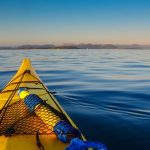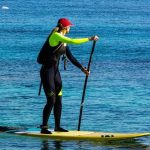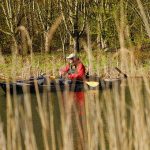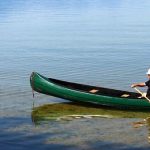On first impression, canoes are quite a basic design. The dimensions of their cockpit don’t leave much to be guessed.
When you start looking into canoes, you quickly comprehend that they all handle differently and that minor adjustment to its arrangements will lead to major discrepancies in your journey.
Once you have acquired a canoe that is best suited for your needs, you may make modifications and additions to customize it to your preferences. These could be modifications to the canoe itself or gear that would make your time on the water more convenient.
You can outfit your canoe and all the necessary equipment with lots of accessories to make sure you get the most out of your setup.
This tutorial outlines the necessary items for both leisure and long excursions you can bring along when you go canoeing. This list will be useful for you when deciding what to bring on your canoe trips, even though you may not need all of the items for every trip.
best accessories you need for your canoe
Barrel
Plastic barrels that are impermeable to water are an often-used way of stowing things in a canoe. The tight closure of these boxes is secured with a metal clip, and it is so effective that your supplies remain dry even if your canoe is submerged under water. It is essential to not overcrowd the drum, as this may slightly relax the seal and let water in.
Canoeists normally go for 30 liters and 60 liters when it comes to barrels, although they come in a variety of sizes. You have enough room for an excursion lasting one day with 30 liters and you can bring your snack, extra clothing, and an emergency medical kit.
If you plan to go on a journey, a 60-liter container will be suitable for your traveling supplies, and a 30-liter container will be ideal for packing the items you might require during the course of the day.
The key benefit to barrels is their sturdiness. Barrels are not susceptible to tearing like dry bags, and it would take a great amount of force to break through them. Although certain individuals may have a contrary opinion, it is still necessary to be careful with food near the camping area, since it is not guaranteed to be bear-proof.
Barrel Harness
If you’re setting out on a journey and must take your gear over dangerous rapids that cannot be avoided, or between different lakes, you should use a harness. A 60-liter container that is filled to the brim can be very heavy, often weighing more than 50 pounds.
Barrels typically have plastic handles affixed, however, these aren’t a pleasant way of carrying such a large amount of material. A barrel harness offers you a customizable support system for transporting your stuff.
Barrel harnesses that are adjustable are the superior choice since they can be adapted to different sized barrels. If you have more than one barrel that needs to be transported, you may utilize the same harness for each one, instead of purchasing another barrel harness.
Backpack style Dry Bag
The barrels may be well-designed, but most can be bulky to wear, particularly during extended journeys carrying them. The NRS Bill’s Bag is a dry bag that resembles a backpack and can be carried comfortably, even over extended distances, compared to other styles of bags.
These dry bags are built to handle the challenging conditions that accompany canoe trips. An added benefit to using a dry bag, aside from the comfort, is that they can be compressed.
If your bag is not full, you can make it less bulky by rolling the top down more tightly or by removing excess air, thus taking less space in your canoe.
Small Day-Bag
When you can, it is best to refrain from opening your barrel or dry bag. At first, they will probably be secured to your canoe or stored in a way that keeps them from being released.
The more times you open and shut your bag or barrel, the higher risk there is of not sealing it back up securely, meaning that your supplies for the trip may be subjected to moisture.
I suggest acquiring a smaller waterproof bag to store snacks, spare coats, medical kits, headlamps, and any other items you might need while sailing. If you are a fan of barrels, a container of thirty liters in size or smaller would work for this task.
Maybe the Watershed Ocee is the best dry bag to use in this situation, since it can protect gadgets and important items.
Tarp
I can’t recall ever undertaking a canoe excursion without a waterproof tarp. No matter the type of tarp you have- be it an all-purpose tarp, or one with several connecting points, it can be used for a variety of applications.
Tarps can be handy to use as cover if you happen to be having your meal when there is heavy rainfall. In the event of an emergency, you can use tarps to create a shelter if you’re stuck in bad weather or hazardous conditions.
It is possible to hunker down and wait for help to arrive, or alternatively you could use the tarp shelters to spend the night.
Tarps can be employed as sails, eliminating the need for another type of gear. This can be done easily with one person manning the tarp or two people together operating the covering. You could construct a sail from poles and cords to traverse quickly.
Padded Seat
Canoes can be used either sitting or kneeling. Standing for an extended period of time can be cumbersome, particularly if it happens in a rough environment or near a waterway. Perching on the chairs might preserve your knees, but it can cause undue tension on your spine in return.
Fastening a kayak chair to your seat allows you to experience the entire backing of a kayak while in your canoe. These chairs have the ability to be modified and they can be folded up and stored when they are not in use.
The extra advantage for them is that when they go to the beach, they can unbuckle the seat from the canoe and relax on the shore.
Air Bags or Blocks
Even the most experienced canoeists sometimes capsize. As you grow in expertise, you may find yourself capsizing in less accessible, tougher situations, leaving you more exposed to the weather. You certainly do not want a complicated rescue operation in this case.
By affixing foam buoyancy blocks or inflation airbags to both extremities of your canoe, you can reduce the amount of liquid that can accumulate in the boat and make it simpler to expel the water.
If you are in an empty boat, you can insert a center floating sack to make any rescue operations even simpler.
Foam buoyancy blocks have more durability than airbags, however, they don’t take up as much room. Airbags can be adjusted to suit your needs, making them more popular than blocks in canoes since they can be inflated if more space is required, or deflated if you need more storage.
These airbags are susceptible to UV damage though.
Kayak life vest
When you are close to a body of water, it is wise to have the right safety equipment. It is essential to be mindful when you are in a boat like a kayak or a canoe, since they are well known for their precariousness and can throw you into the water unexpectedly when you are not prepared.
Despite being a strong swimmer, you still require something to keep you buoyant, which is where a life jacket becomes necessary. A life-vest that is specifically designed for kayaking permits users to move around as they wish, which is essential when partaking in this activity, without interfering with whatever they are doing.
You are searching for a life vest that is not too bulky and allows you to feel at ease. They are all designed to keep you from sinking in the event that you capsize and some of them are watertight so that your belongings remain protected.
Bilge pump
In spite of a campaign to oppose its use, it is justifiable to have a means to get rid of water that could enter your kayak, be it from wave spray or flipping over. This is where a bilge pump comes in. This device is intended to extract any liquid that enters your cockpit, and it offers some different choices.
If you’re going on a calm excursion, a manual pump should be all that you need since you don’t have to hurry to get the water extracted. But if the journey is more challenging, like boating on rapids, perhaps something convenient like an electric bilge pump is the better choice.
An electronic device will expel the water for you, leaving your hands free to paddle and maneuver in the water. No matter what, it is essential that you have a minimum of a hand pump and a bailing sponge.
Spray skirt
A spray skirt is another kayaking essential. A touring kayak has the capability to stay afloat even in rough seas. A recreational kayak will protect you from rainfall and any water disturbances you encounter.
On white water rapids, you can be taken through any currents, down waterfalls, and back up again. A skirt is typically constructed from a tube-shaped component, often referred to as a tunnel, that goes around your waist and a top, which covers the entire boat interior, with the edge securing the top over the entire boat interior. Lots of different materials and styles are available.
Neoprene is commonly chosen by whitewater and surf kayakers, while nylon is the standard option for sea kayakers and both can be used together as well.
It is essential to make sure that the skirt that you are wearing fits securely to both you and the kayak; this way, no water will be able to get into the boat.
Rescue sling (rescue stirrup)
A rescue sling, commonly known as a rescue stirrup, is an intriguing piece of equipment that assists one in getting back into a kayak if it has been overturned. Paddlers often turn to this method when they are exhausted or lack the power in their upper body to pull themselves out of the water onto their boat.
The rescue sling allows you to be placed into a more advantageous spot, enabling you to get back into your kayak. Normally created from brightly colored nylon fibers, a kayak is equipped with a cushion of neoprene fabric, and a set of clips to keep it firmly affixed to the boat.
You have a couple of options for getting into your kayak with a rescue sling, and it’s completely up to you which one you’d like to use. A rescue sling should be able to be easily rolled up and put away for storage.
Dry bag
A dry bag is quite clear, mainly serving as a waterproof pouch that keeps your important items untouched by water. Those who spend their leisure time in the ocean or other bodies of water depend on waterproof devices to keep their food, electronics, or other items from getting wet.
These items are usually durable and highly resistant to wear, which makes them indispensable in cases where there is potential for contact with water. Generally, lightweight items are kept in vinyl cases, while bulky items are stored in nylon pouches incorporating Cordura materials.
These items come in an assortment of closures, some having an added measure of security, and of diverse sizes making sure anything you need to put in the bag can be accommodated, as long as it will still fit in your kayak.
Certain models are equipped with straps that can be removed when they are not required to be carried. These straps give extra convenience.
Map and compass
You might be wondering why you need a map and compass when you’re on a lake or river, but there are still navigational elements to consider. When you’re out on the lake, it is easy to spot your desired destination and all you have to do is paddle your way there.
Whenever you’re outside in a natural environment, you are solely responsible for yourself, relying only on your strength and intelligence. When you’re in a body of water, the situation can be difficult to manage if an issue arises, because there is no place to take cover and take a moment to consider the problem.
Hence, it is important to possess a map and compass that can give you consistently accurate information about where you are located and which you could inform a person in a crisis. Nobody wants to have to paddle an extra mile after making 30 miles of progress.
Whistle
You’ll want to possess a whistle too. It is undeniable that whistling can be heard from a greater distance than speaking, and it is certain that your vocal chords will tire much more quickly than your lips. This simplifies your ability to talk to other people when you’re in the ocean or if there’s a crisis.
in conclusion
Thank you for taking the time to explore the world of canoe accessories with us. Whether you’re a seasoned paddler or just starting out, having the right gear can make all the difference in your experience on the water.
From paddles and life jackets to waterproof storage and fishing equipment, we’ve covered all the essential accessories you need to make your next canoeing adventure a success.
Remember, investing in high-quality accessories not only enhances your safety and comfort but also ensures that you get the most out of your time on the water. So don’t hesitate to shop around and find the accessories that best suit your needs and preferences.
At Canoe Accessories People Need, we’re passionate about providing you with the latest and greatest gear, along with expert advice and tips to help you get the most out of your canoeing adventures.
So why wait? Start exploring our range of accessories today and get ready to experience the thrill and beauty of canoeing like never before!




